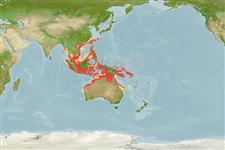Teleostei (teleosts) >
Eupercaria/misc (Various families in series Eupercaria) >
Nemipteridae (Threadfin breams, Whiptail breams)
Etymology: Nemipterus: Greek, nema, -atos = filament + Greek, pteron = wing, fin (Ref. 45335).
More on authors: Quoy & Gaimard.
Environment: milieu / climate zone / depth range / distribution range
Ecology
Marine; demersal; non-migratory; depth range 10 - 80 m (Ref. 9785). Tropical; 27°N - 28°S, 93°E - 165°E (Ref. 3810)
Western Pacific: Andaman Sea to the Solomon Islands.
Size / Weight / Age
Maturity: Lm ? range ? - ? cm
Max length : 23.0 cm SL male/unsexed; (Ref. 108462); common length : 15.0 cm SL male/unsexed; (Ref. 9785)
Dorsal spines (total): 10; Dorsal soft rays (total): 9; Anal spines: 3; Anal soft rays: 7. Suborbital spine absent. Preopercle with 3 transverse scale rows. Pectoral fins long, reaching to or beyond level of anus. Pelvic fins very long, reaching to or just beyond level of anus. A line drawn up from posterior edge of suborbital reaching the dorsal profile at about 2 to 6 scale rows before origin of dorsal fin. Upper lobe of caudal fin slightly longer than lower, tipped with yellow. Females predominate at small sizes, males at larger sizes. Axillary scale present. Color: Upper body pinkish, silvery white below.
Occurs on mud or sand bottoms. Most abundant in depths of 20 to 50 m. Feeds mainly on small shrimps, squid, small fishes and benthic animals.
Life cycle and mating behavior
Maturities | Reproduction | Spawnings | Egg(s) | Fecundities | Larvae
Females predominate at small sizes and males at larger sizes as result of faster growth rates in males.
Russell, B.C., 1990. FAO Species Catalogue. Vol. 12. Nemipterid fishes of the world. (Threadfin breams, whiptail breams, monocle breams, dwarf monocle breams, and coral breams). Family Nemipteridae. An annotated and illustrated catalogue of nemipterid species known to date. FAO Fish. Synop. 125(12):149p. Rome: FAO. (Ref. 3810)
IUCN Red List Status (Ref. 130435)
Threat to humans
Harmless
Human uses
Fisheries: minor commercial
Tools
Special reports
Download XML
Internet sources
Estimates based on models
Preferred temperature (Ref.
123201): 25 - 29, mean 28.1 °C (based on 1040 cells).
Phylogenetic diversity index (Ref.
82804): PD
50 = 0.5000 [Uniqueness, from 0.5 = low to 2.0 = high].
Bayesian length-weight: a=0.01445 (0.01202 - 0.01738), b=2.97 (2.93 - 3.01), in cm total length, based on LWR estimates for this species (Ref.
93245).
Trophic level (Ref.
69278): 3.9 ±0.3 se; based on diet studies.
Generation time: 1.4 (1.1 - 2.3) years. Estimated as median ln(3)/K based on 12
growth studies.
Resilience (Ref.
120179): High, minimum population doubling time less than 15 months (K=0.4-0.6).
Fishing Vulnerability (Ref.
59153): Low vulnerability (19 of 100).
Nutrients (Ref.
124155): Calcium = 525 [123, 997] mg/100g; Iron = 1.51 [0.47, 4.18] mg/100g; Protein = 17.8 [16.1, 19.4] %; Omega3 = 0.28 [0.13, 0.62] g/100g; Selenium = 36 [14, 111] μg/100g; VitaminA = 17.3 [4.1, 98.1] μg/100g; Zinc = 0.781 [0.446, 2.664] mg/100g (wet weight);
